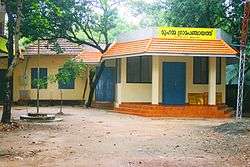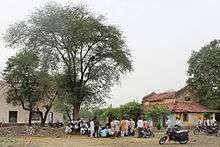Panchayati raj (India)
 |
| This article is part of a series on the politics and government of India |
|
|

The Panchayati Raj in India generally refers to the system introduced by constitutional amendment in 1992, although it is based upon the traditional panchayat system of South Asia. The modern Panchayati Raj and its gram panchayats are not to be confused with the extra-constitutional khap panchayats (or caste panchayats) found in northern India.[1] The panchayati raj system was formalized in 1992, following a study conducted by a number of Indian committees of various ways of implementing more decentralized administration.

Mahatma Gandhi advocated panchayati raj as the foundation of India's political system, as a decentralized form of government in which each village would be responsible for its own affairs.[2][3] The term for such a vision was Gram Swaraj ("village self-governance"). Instead of it India developed a highly centralized form of government.[4] However, this has been moderated by the delegation of several administrative functions to the local level, empowering elected gram panchayats. There are significant differences between (1) the traditional panchayati raj system, (2) that envisioned by Gandhi, and (3) the system formalized in India in 1992.[5]
In India, the Panchayati Raj now functions as a system of governance in which gram panchayats are the basic units of local administration. The system has three levels: gram panchayat (village level), mandal parishad or block samiti or panchayat samiti (block level) and zila parishad (district level).[6] It was formalized in 1992 by the 73rd amendment to the Indian Constitution.[7]
Various Committees on Panchayati Raj :
1. Balwant Rai Mehta : Estd 1957
2. V.T.Krishnammachari : 1960
3. Takhatmal Jain Study Group: 1966
4. Ashok Mehta Committee : 1977
5. G.V.K Rao committee :1985
6. Dr.L.M.Singhvi Committee:1986
Recommendations of Balwant Rai Mehta Committee
The Balwant Rai Mehta Committee, headed by MP Balwantrai Mehta, was a committee appointed by the Government of India in January 1957 to examine the work of the Community Development Programme (1952) and the National Extension Service (1953) and to suggest measures for their better work. The recommendations of the committee were approved by NDC in January 1958, and this set the stage for the launching of Panchayati Raj Institutions throughout the country. The committee recommended the establishment of the scheme of ‘democratic decentralisation’ which finally came to be known as Panchayati Raj.
(i) Establishment of a 3-tier Panchayati Raj system - Gram Panchayat at the village level, Panchayat Samiti at the block level, and Zila Parishad at the district level.
The Panchayat Raj system was first adopted by the state of Rajasthan in Nagaur district on 2nd Oct 1959. The second state was Andhra Pradesh, while Maharashtra was the Ninth state. This system was adopted by state governments during the 1950s and 60s, as laws were passed to establish panchayats in various states. It also founded backing in the Indian Constitution, with the 73rd amendment in 1992 to accommodate the idea. The Amendment Act of 1992 contains provision for devolution of powers and responsibilities to the panchayats, both for the preparation of economic development plans and social justice, as well as for implementation in relation to 29 subjects listed in the eleventh schedule of the constitution.[8]
The panchayats receive funds from three sources:[8]
- Local body grants, as recommended by the Central Finance Commission
- Funds for implementation of centrally sponsored schemes
- Funds released by the state governments on the recommendations of the State Finance Commissions
In the history of Panchayati Raj, in India, on 24 April 1993, the Constitutional (73rd Amendment) Act 1992 came into force to provide constitutional status to the Panchayati Raj institutions. This act was extended to Panchayats in the tribal areas of eight states, namely Andhra Pradesh, Gujarat, Himachal Pradesh, Maharashtra, Madhya Pradesh, Odisha and Rajasthan starting 24 December 1996. Currently, the Panchayati Raj system exists in all the states except Nagaland, Meghalaya and Mizoram, and in all Union Territories except Delhi.[9] The Balwant Rai Mehta Committee was a committee appointed by the Government of India in January 1957 to examine the working of the Community Development Programme (1952). The Act aims to provide a 3-tier system of Panchayati Raj for all States having a population of over 2 million, to hold Panchayat elections regularly every 5 years, to provide seats reservations for scheduled castes, scheduled tribes and women; to appoint a State Finance Commission to make recommendations regarding the financial powers of the Panchayats and to constitute a District Planning Committee, to prepare a development plan draft for the district. The 3-tier system of Panchayati Raj consists of:
- Village-level Panchayats
- Block-level Panchayats
- District-level Panchayats.
Powers and responsibilities are delegated to panchayats at the appropriate level:
- Preparation of the economic development plan and social justice plan.
- Implementation of schemes for economic development and social justice in relation to 29 subjects given in the Eleventh Schedule of the Constitution.
- To levy and collect appropriate taxes, duties, tolls and fees.
Block level panchayat
A panchayat Samiti (block panchayat) is a local government body at the tehsil level. This body works for the villages of the tehsil that together are called a "development block". The panchayat Samiti is the link between the gram panchayat and the district administration. Just as the "tehsil" goes by other names in various part of India, notably "mandal" and "taluka", there is a number of variations in nomenclature for the block panchayat. For example, it is known as "Mandal Praja Parishad" in Andhra Pradesh, "taluka panchayat" in Gujarat, "Taluk panchayat" in Karnataka, and "panchayat Samiti" in Maharashtra. In general, the block panchayat has the same form as the gram panchayat but at a higher level.
Constituency
Membership in the block panchayat is mostly ex-official; it is composed of all of the Sarpanchas (gram panchayat chairmen) in the panchayat Samiti area, the MPs and MLAs of the area and the sub-district officer (SDO) of the subdivision, co-opt members (representatives of the SC/ST and women), associate members (a farmer of the area, a representative of the cooperative societies and one from marketing services), and some elected members.
The panchayat Samiti is elected for a term of five years and is headed by a chairman and a deputy chairman.
Departments
The common departments in the Samiti are as follows:
- General administration
- Finance
- Public work
- Agriculture
- Health
- Education
- Social welfare
- Information technology
- Water Supply Dept.
- Animal Husbandry and others.
There is an officer for every department. A government-appointed Block Development Officer (BDO) is the executive officer to the Samiti and the chief of its administration, and is responsible for his work to the CEO of ZP.
Functions
- Implementation of schemes for the development of agriculture and infrastructure.
- Establishment of primary health centres and primary schools.
- Supply of drinking water, drainage and construction/repair of roads.
- Development of a cottage and small-scale industries, and the opening of cooperative societies.
- Establishment of youth organisations.
.
District level panchayat
The governing of the advance system at the district level in Panchayat Raj is also popularly known as "Zila Parishad". The Chief of administration is an officer of the IAS cadre.
Functions
- Provide essential services and facilities to the rural population
- Supply improved seeds to farmers and inform them of new farming techniques
- Set up and run schools and libraries in rural areas
- Start Primary Health Centers and hospitals in villages; start vaccination drives against epidemics
- Execute plans for the development of the scheduled castes and tribes. Run ashram shalas for Adivasi children. Set up free hostels for them
- Encourage entrepreneurs to start small-scale industries and implement rural employment schemes
- Construct bridges, roads & other public facilities and their maintenance
- Provide employment
Sources of Income
1.Taxes collected locally such as on water, place of pilgrimage, local mandirs, and markets, etc
2.A fixed grant from the State Government in proportion to the land revenue and money for works and schemes assigned to the Parishad.
Village level panchayat
A gram panchayat is a village level administrative body, with a Sarpanch as its elected head. The members of the Gram Panchayat are elected for a period of five years by the members of Gram Sabha.[10]
Reservation for women in PRIs in India
On August 27, 2009, The Union Cabinet of the Government of India approved 50% reservation for women in PRIs (Panchayati Raj Institutions). The Indian states Madhya Pradesh, Bihar, Uttarakhand, Himachal Pradesh,[11] Andhra Pradesh, Chhattisgarh, Jharkhand, Kerala, Karnataka, Maharashtra, Orissa, Rajasthan and Tripura have implemented 50% reservation for women in PRIs.[12][13] The majority of candidates in these Panchayaths are women. Currently 100% of elected members in Kodassery Panchayat in Kerala are Women.[14]
See also
Notes and references
- Notes
- ↑ Mullick, Rohit & Raaj, Neelam (9 September 2007). "Panchayats turn into kangaroo courts". The Times of India. Retrieved 7 June 2015.
- ↑ Sisodia, R. S. (1971). "Gandhiji's Vision of Panchayati Raj". Panchayat Aur Insan. 3 (2): 9–10.
- ↑ Sharma, Manohar Lal (1987). Gandhi and Democratic Decentralization in India. New Delhi: Deep and Deep Publications. OCLC 17678104. Hathi Trust copy, search only
- ↑ Hardgrave, Robert L. & Kochanek, Stanley A. (2008). India: Government and Politics in a Developing Nation (seventh ed.). Boston, Massachusetts: Thomson/Wadsworth. p. 157. ISBN 978-0-495-00749-4.
- ↑ Singh, Vijandra (2003). "Chapter 5: Panchayate Raj and Gandhi". Panchayati Raj and Village Development: Volume 3, Perspectives on Panchayati Raj Administration. Studies in public administration. New Delhi: Sarup & Sons. pp. 84–90. ISBN 978-81-7625-392-5.
- ↑ Nath, Akshaya (24 April 2015). "National Panchayati Raj Day: Here are few things that you need to know about Panchayati Raj". SaddaHaq.
- ↑ "The Constitution (Seventy-third Amendment) Act, 1992". Government of India. Archived from the original on 5 May 2003.
- 1 2 India 2007, p. 696, Publications Division, Ministry of Information and Broadcasting, Government of India
- ↑ panchayat.nic.in
- ↑ Sapra, Ipsita (February 2013). "Living in the villages". Rural Democracy. D+C Development and Cooperation. Retrieved 24 April 2015.
- ↑ 50pc reservation for women in panchayats - Oneindia News. News.oneindia.in (2009-08-27). Retrieved on 2013-07-28.
- ↑ 50% reservation for women in AP, Bihar Panchayats. Sify.com (2011-11-25). Retrieved on 2013-07-28.
- ↑ http://www.mathrubhumi.com/women/features/mayor-malayalam-news-1.696624
- ↑ http://www.mathrubhumi.com/women/news/lsgd-womans-malayalam-news-1.694513
- Sources
- Nepal glossary, United States Library of Congress
- Article 333357, zeenews.com
- Article India994-07, hrw.org.
- Panchayati raj Recruitment, Exambuzzer.com
Further reading
- Subrata K. Mitra and V.B. Singh. 1999. Democracy and Social Change in India: A Cross-Sectional Analysis of the National Electorate. New Delhi: Sage Publications. ISBN 81-7036-809-X (India HB) ISBN 0-7619-9344-4 (U.S. HB).
- Subrata K. Mitra. 2001. Making local government work: Local elites, Panchayati raj and governance in India, in Atul Kohli (Ed.). The Success of India's Democracy. Cambridge: Cambridge University Press.
- Subrata K. Mitra. 2003. Politics in India, in Almond, Gabriel/Bingham Powell/Russell Dalton/Kaare Strøm (Eds.), Comparative Politics Today. 8th edition. New York: Addison-Wesley-Longman, pp. 634–684.
External links
| Wikimedia Commons has media related to Panchayati Raj. |
- Ministry of Panchayati Raj, Government of India
- "Home page". Department of Rural Development, Ministry of Rural Development, Government of India.
- "Panchayat (article 440944)". Encyclopædia Britannica. Archived from the original on 29 January 2012. about the caste panchayats
- The Hunger Project. "Two Million Women Leaders and Counting: Indian Women Participate in Their Local Government". International Museum of Women. Archived from the original on 30 June 2015.
- [National Agriculture Education Institution Image Panchayat Raj Symbolhttp://nationalagriedu.blogspot.in/ ]